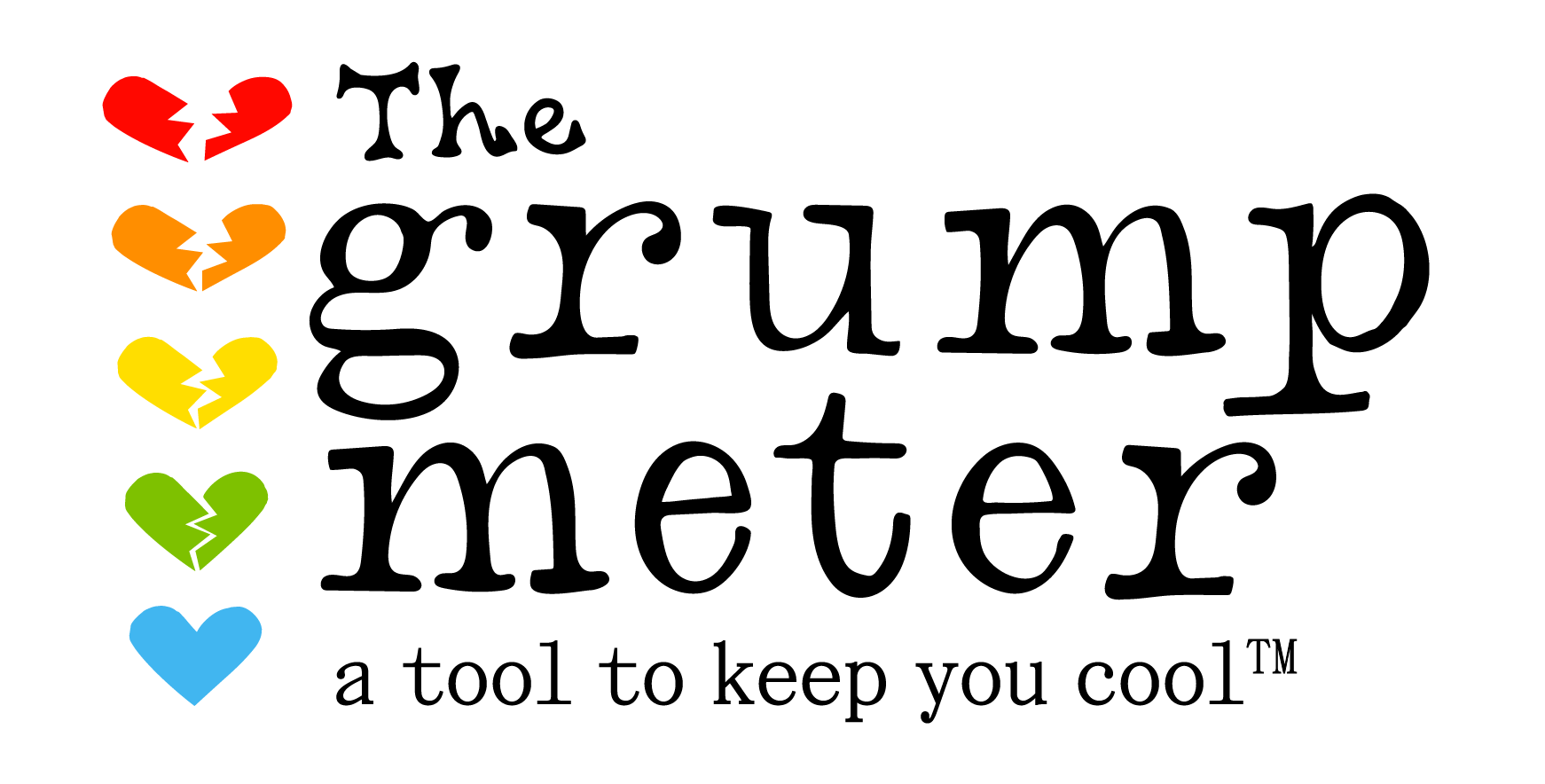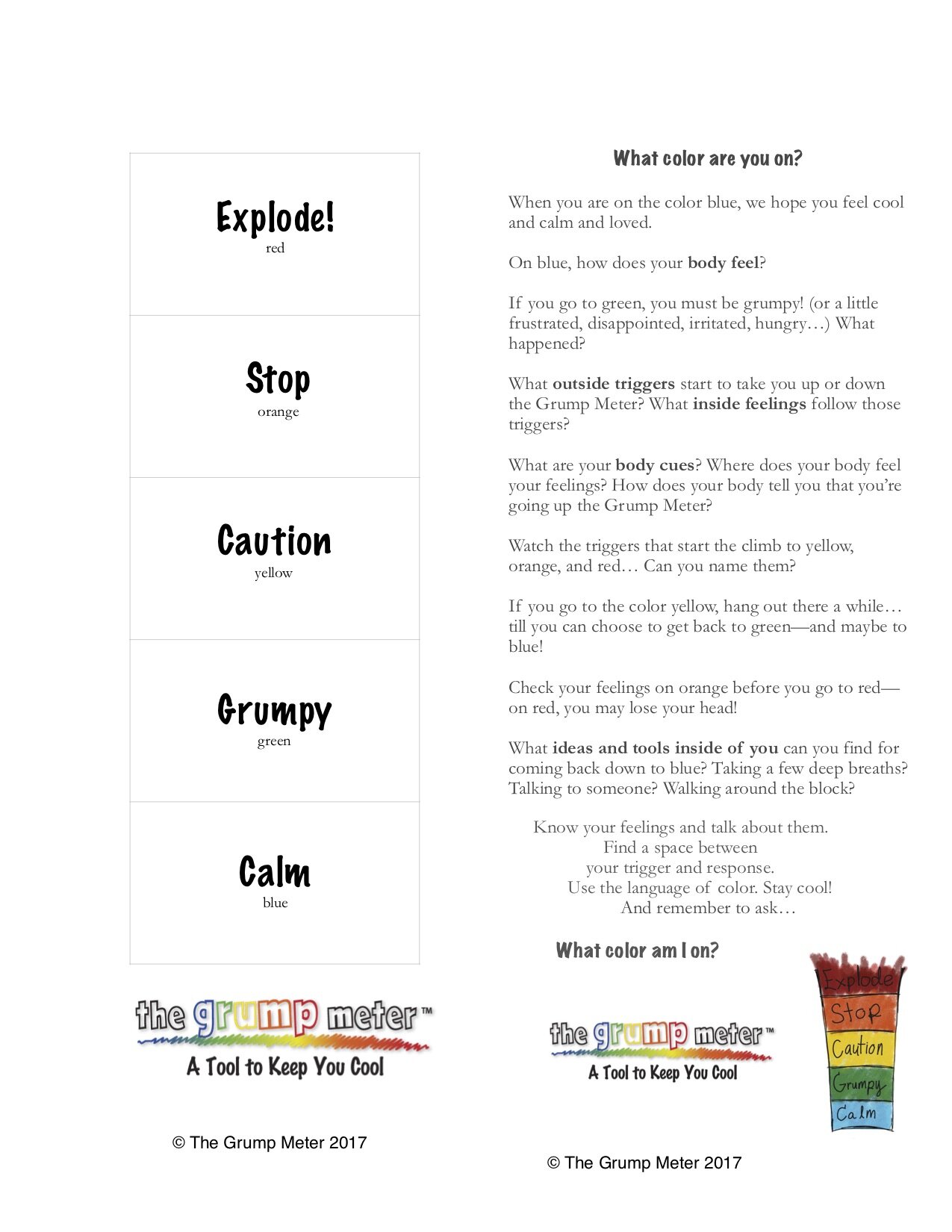Get Started—
Activities
Download your personal, portable Grump Meter
Click on this page and print. Fold it vertically in half—"hot dog” style. On one side you’ll have a Grump Meter. On the other, suggestions for how to use it!
The Grump Meter is a powerful tool. Just like with any other tool, it's only helpful if you use it. Practice, practice, practice!
Use the Grump Meter book & workbook. The book has a special section for kids and adults to read together, and the adult section offers more understanding, examples, and approaches to using the Grump Meter. The workbook contains 26 pages of exercises to help children build self-awareness and self-control.
A Library of Grump Meter ideas!
Families, teachers, therapists, youth group leaders, and others have found many great ways to build upon and reinforce Grump Meter skills. We're assembling a library of ideas here: We'd love to hear yours—please contact us!
Daily Practice
Daily practice and planning Helps you develop awareness and self-Regulation.
Ask yourself and those around you, "What color are you on?" Look in the Grump Meter mirror.
Use the Grump Meter every day —at night, too! Use the Grump Meter language like code. Ex: “I’m on yellow… I need a break” or “Let’s talk when we’re both on blue.”
Notice your feelings in your body. Where do you hold them? Do you get headaches? back aches? stomach aches? What does your body telling you about your feelings?
What feelings can you identify? frustration? sadness? worry? fear? What color do these take you to?
Place reminders for self-regulation where you will see them— tape Grump Meters to the fridge, a closet door, your car dashboard. For children, try making bookmarks, rainbow bracelets, fidget bead crafts, t-shirts....
Think about blue. How is blue best? What’s the cost of going to red?
Identify a safe place to take a break or some deep breaths when you’re going up toward yellow.
Plan in advance. Can you anticipate triggers? Make a plan to avoid going up the Grump Meter. Be specific. Ex: "The next time he bugs me, I will walk away.”
Communication
The Grump Meter provides a new language for communication!
The Grump Meter’s Language of Color gives you five colors to communicate the intensity of your feelings—no matter what those feelings are. The Grump Meter Book and Workbook explain the colors and how to use them.
Use the five colors to engage in respectful, kind, safe, curious conversation. Try using phrases such as:
•"What color are you on?"
•"I'm on green because...”
•“I would like to do X to feel calmer, for about a half hour. That will help me come down the Grump Meter.”
•“I want to talk with you, but let’s wait until we’re both on blue.”
•"Would you do X? That would help me come back to blue."
Adults and kids can use Grump Meter language together
for compassionate, peaceful interactions.
The language of color gives kids a simple, playful way to express big feelings.
It gives adults neutral language to discuss strong emotions.
Art & Creativity
The Grump Meter opens the door for playful, creative projects. Practice and strengthen your communication and relationships. The workbook offers guided exercises with art, writing, and role-playing. Try these idea, too:
Use fabric markers and white t-shirts to make Grump Meter t-shirts—this is great fun for a group!
Write a Grump Meter poem.
Pick an animal to draw or describe that could help you get back to blue.
Draw yourself on each of the colors.
Write a poem about blue.
Draw a picture of how you feel on blue.
Read a story. Think of it in Grump Meter terms. What color was the character on at various points of the story? What were the character's triggers? How did things go for the character when they were on blue? What happened as the character went up the Grump Meter?
Kids—Developing Tools
The Grump Meter toolbox has tools that are all within you—your eyes, ears, brain, hands, feet… All these parts of you can help you find ways to understand and express your feelings, and stay on blue.
Kids and parents can work together on the Workbook.
Here are ways to add more tools to your toolbox.
Take a Grump Meter inventory. List your subjects, activities, chores—math, P.E., lunch, cleaning your room. Which color on the Grump Meter do you go to for each? Does math take you to yellow? Are you on blue during P.E.? Talk to a parent or teacher about it. Make a plan to help you stay on blue.
Keep a journal. You will learn a lot about YOU! Write or draw about your feelings. What triggers take you up the Grump Meter? What helps you come back to blue? What patterns do you see? How does writing or drawing help you stay on blue?
Listen to your body. What does it tell you? What physical cues alert you when you start climbing up the Grump Meter?
Neutral and positive self-talk are your power tools. Remind yourself often of your strengths. You ARE able to be in control. (The workbook will help you understand self-talk)
Add neutral and positive self-talk to your toolbox often.
What compliments do people give you? Put them in your toolbox. Listen to these.
Practice your Emotional Vocabulary. Do this when you’re on blue and green. Think of words to describe the feelings you have when you go up the Grump Meter. When you can name your feelings, you can tame them. Spend more time on BLUE!
Self-Control
Understanding your triggers and preparing to greet them will help you build self-management—so you act in ways bring you pride, and align with your values and commitments.
Chart what color you are on at different times throughout the day. Do this for several days. Do you see any patterns?
Write five triggers that send you up the Grump Meter.
Listen to your body. Where does your body feel those triggers? What messages does it give you?
Can you see those triggers in your mind’s eye? Watch them carefully? Observe them?
What can you safely say or do to calm your body, heart, and mind? The Grump Meter toolbox can help you figure this out! Use the Grump Meter app or Toolbox cards!
Work through your workbook. Go back through it. Review it. Add to it. Keep working on it. The more ideas you put in your workbook, the stronger your self control will be!
Safety
Oh no, don't go to RED! Calm down!
On red, people and things get hurt. We lose control, do things we regret. Avoid red.
When parents go up the Grump Meter, children don't feel safe. When kids go up the Grump Meter, parents worry. When adults go up the Grump Meter at work, conflict erupts.
How do we keep safe environments for ourselves and each other?
To create emotional safety and Find blue:
If you think someone is going up the Grump Meter, ask what color they’re on.
If they're on yellow, orange, or red, listen. Pay special attention.
Ask what’s needed? Who’s needed? Where are resources?
Practice mindful breathing.
Take a recuperative time out.
Make a plan.
List reasons to find blue.
List things you are grateful for.








